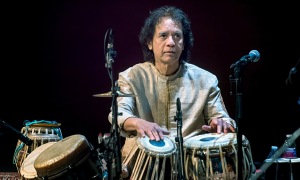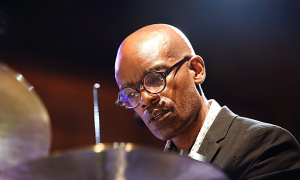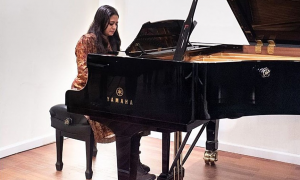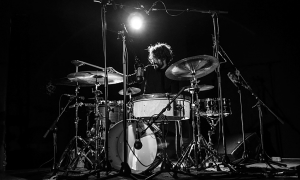Home » Jazz Articles » Under the Radar » Charu Suri: The Jazz Raga
Charu Suri: The Jazz Raga

You can't just throw in a jazz lick and improvise a few bars and call it a day; the transparency of a trio demands your fullest attention from beginning to end, of every band member.
—Charu Suri
The Roots of Indo-Jazz
Jazz and Indian ragas share common ground in their traditional use of improvisation. They are often talked about in compatible terms, but Ravi Shankar, for one, did not believe that ragas could be compared to jazz improvisation. Spontaneous creation in jazz differs from the complex rhythmic structural patterns of Indian improvisation. Shankar became the embodiment of non-western music in the 1960s. Jazz enthusiasts filled his audiences, quickly adapting techniques without any serious degree of due diligence. Nevertheless, his collaborations with jazz musicians laid the groundwork for Indo-Jazz.Bohemian composer and, ethnomusicologist Walter Kaufmann dedicated twenty-five pages of his book The Ragas of North India (Indiana University Press, 1968) to defining the raga. Its meaning still isn't exactly set in stone other than to broadly describe the form as ..."a musical entity that includes note intonation, relative duration and order, in a manner similar to how words flexibly form phrases to create an atmosphere of expression." Raga, in Sanskrit, means "color." Also spelled "rag" (in northern India) or "ragam" (in southern India), it is the classical music of India, Bangladesh, and Pakistan, a melodic framework for improvisation and composition. The music of the sub-continent is likely to have originated, like the sitar, in the Persian world.
Raga improvisation is rule-based: the specific notes are pre-determined, as is their order—the transition from one note to another. Microtones are often a feature of these compositions as they differentiate similar ascending and descending notes. "Sargam" is improvisation that consists of singing notes rather than words, again, with restrictions. Hypothetically, there are potentially thousands of ragas possible but in real-world use, the classical Indian tradition relies on several hundred. Some ragas are considered completely "improvised" but remain confined to guidelines, limitations that would not be present in even traditional jazz. This interpretation of improvisation is not unknown to Western music. Some 18th century classical music may have twenty movements, and the musicians could choose a half-dozen depending on the type of performance.
The jazz age came to Bombay in the mid-1930s as the effects of the Great Depression eased. Bombay was Mumbai under British rule from 1858 until the independence of India and Pakistan in 1947 but in the 1930s the busy port city was flexing a self-determining attitude. Western ideas, especially in the arts, were growing in popularity, including jazz. Leon Abbey (1900—1975) was an American jazz violinist and bandleader from Minnesota. In 1935 he toured Bombay with his eight-piece band and his foxtrot repertoire became an overnight sensation among the elite class in the city. A jazz network was established between Bombay, Shanghai and Paris-based African American musicians who established a "Harlem in Montmartre" conclave. That community fractured due to French quotas limiting non-citizen musicians but a number of the expatriates set up shop in Bombay and Calcutta.
It was Indian composers who initiated the merger of musical cultures, often under the umbrella of Hindi film music. Shankar Singh Raghuvanshi and Jaikishan Panchal were considered the greatest composers in Indian theater and cinema and their work spanned four decades. Both were fine musicians, influenced by Americanized jazz. Working with jazz veterans in Bombay, they adapted a dozen classical ragas with swing elements but these early experiments were rarely recorded.
The Birth of Indo-Jazz
The album Jazz Raga (Impulse!, 1966) was considered a cross-genre breakthrough in the West. But the album came by way of Hungarian guitarist/sitarist Gabor Szabo and an American rhythm section. The quality is dubious, with Szabó's sitar out of tune, but the unique sound earned a cult following. Far more inspiring is Jazz Meets India (SABA, 1967). Billed as the Dewan Motihar Trio at its original release, the title varied by market. In Germany, the European contributors received top billing as Manfred Schoof, Barney Wilen, Irene Schweizer & Dewan Motihar Trio; in Japan, The Irene Schweizer Trio. East met West here but each stayed in their respective lane. Jazz Meets India was a seamless transition of philosophies, beautifully performed by the Indian trio of sitar, tambura, and tabla, and a jazz piano trio leaning toward free playing.Indo-Jazz was not a ubiquitous subgenre, sporadically popping up as a stand-alone track on otherwise homogenized collections. The popularity of Ali Akbar Khan and Ravi Shankar grew in the West in the 1960s and Khan eventually established a College of Music in the San Francisco area. Indian music influenced Western rock music of that era in a more profound way. Shankar brought the raga to mass audiences at the 1967 Monterey Festival, the Woodstock Festival (1969) and as co-organizer of George Harrison's 1971 Concert for Bangladesh. Another example of raga rock is heard on David Crosby's "Why" from the Roger McGuinn led Byrds album Younger Than Yesterday (Columbia, 1967). Indian tabla virtuoso Zakir Hussain worked with Mickey Hart, Jefferson Starship and Van Morrison.
Ravi Shankar had made a smaller inroad with jazz fusion on the track "Improvisation on the Theme Music from 'Pather Panchali.'" Shankar's collaboration with Gary Peacock and saxophonist Bud Shank on the album Improvisations (World Pacific Records, 1962) was considered pioneering. Indian violinist John Mayer released another revolutionary album, Indo-Jazz Suite (Columbia, 1966) with saxophonist Joe Harriott, Dewan Motihar, and Kenny Wheeler. The American percussionist Collin Walcott studied sitar under Shankar and tabla under Alla Rakha. He played with Miles Davis, Brazillian guitarist/pianist Egberto Gismonti, and Codona with Don Cherry and Nana Vasconcelos. Walcott's three ECM solo albums feature some outstanding Indo-jazz, especially on Grazing Dreams (1977). Ragas and Sagas (ECM, 1990) brought saxophonist Jan Garbarek together with Pakistanis Ustad Fateh Ali Khan, Ustad Shaukat Hussain, and others. The music is more typical of the South Asian subcontinent but with Garabek's Western style improvisation.
Charu Suri
Charu Suri, a pianist and wide-ranging composer, has a history that requires some processing. She was born in India, raised in Africa, graduated from Princeton University, and performed at Carnegie Hall and Lincoln Center. Ms. Suri is the first female Indian-American jazz composer to premiere her work at Carnegie Hall. As an author, she has contributed to The New York Times, Architectural Digest, Condé Nast Traveler and other publications. In addition, she is Editor of Wellness Lounge, an online health magazine.Suri has released four albums as a leader, all on the Amala Records label. Her music has spanned traditional jazz, as with The New American Songbook (2019) and Indo-Jazz on The Book of Ragas (2019). Her most recent release, The Book of Ragas, Vol 2 (2021) is another amalgam of her diverse musical and cultural interests.
All About Jazz: Please tell me about where you grew up and what your earliest musical memories are?
Charu Suri: I was born in Madurai, a Southern Indian city known for its poets and music traditions. The earliest musical memories I have are those of my grandmother singing several Indian songs (she has a beautiful voice), and my father playing classical Indian ragas each morning on the radio. I started playing the piano when I lived in Africa from the age of five. My father was the CEO of a record label, and I would listen to hundreds of discs on vinyl, in all genres from rock to classical to jazz. We had a piano in our home at that time in Nigeria, and I just practiced for hours a day on it.
AAJ: Who, or what, inspired your interest in jazz music?
CS: I guess the art of improvisation has always been in my heart since I learned both Indian classical music and western music. I would doodle and improvise for hours at a time, even at the age of 5 and 6, long before I even knew what the word "improvise" actually meant. It was just a given to me that a melody should be riffed in some way, and a raga should be transformed in some way...so in that sense, the art of jazz was something I was into even before I could label it "jazz." More formally, I was introduced to jazz in my teens when I heard the sounds of Bill Evans and Miles Davis, and later on at Princeton University where I went to undergraduate and Manhattan School of Music for grad school.
I couldn't separate the idea of "Western" jazz and "Eastern" jazz in my mind, even though the term "jazz" formally had its start in New Orleans in the early 1900s, it was something I had always been exposed to melodically, if not chordally. It was only much much later, when I started my jazz band in 2018, that I started to teach myself jazz chords, and harmonic progressions that one commonly associates with jazz. So in that sense, my formal exposure to that genre has been fairly recent.
AAJ: When was the first time you played Carnegie Hall? What did you think and feel when you first walked onto that prestigious stage?
CS: The first time I performed at Carnegie Hall was in December 2019, when I premiered The Book of Ragas (Vol 1) and The New American Songbook, it was really surreal. I had heard of this stage and dreamed about it since I was a kid and it was actually happening and I felt as though I were in Alice in Wonderland. The rehearsal rooms all had Steinway uprights in them! I was excited to test out the acoustics that I had heard so much about, and I remember whispering onstage and asking one of my band members to see if it was audible without amplification from the balcony, and yes it was! We didn't get microphones or any fancy equipment—it was a completely acoustic, natural setting.
I remember being very comfortable on the stage, I had zero nerves. Because Weill Recital Hall is intimate, I could see and hear and communicate with my band and my audience. It felt like a classy jazz club, complete with chandeliers. I was really happy on my dream stage that evening!
AAJ: The scope of your career is broad. As a journalist, you have written for Architectural Digest, The New York Times, Vogue, and other well-known publications. Writing and composing both require inspiration but the creative process can be quite different. Where do you see the similarities?
CS: The similarities actually lie in the creativity. Both writing and music are very detail-oriented, but even though one is more fact-based, both require a lot of energy and creativity. It's not easy to write an original story, nor is it easy to create an inspired and original piece of music. Also, both rely on the art of communication. I find it interesting and inspiring to convey my thoughts and emotions through these different mediums.
AAJ: You studied classic literature and musical performance at Princeton University. It seems like you have always had a fairly clear career direction in mind. Is that the case, or had you considered other paths?
CS: Yes, I've often thought that my ideal career, or in this case, careers, would include writing and music. Those are the subjects I loved as a child, and continue to love the best. The issue for me was to figure out just how to channel my musical energies. Even though I was trained as a classical concert pianist, I knew I didn't want to just play the same old repertoire; I wanted to create something new, and something really original. I had considered being a film composer for a while and I still consider this, and I had a brief stint on Wall Street but I quickly realized that this wasn't my calling.
AAJ: Can you describe your process for composing?
CS: I think almost every single piece I've written, and definitely the ones I've recorded, started with an intense feeling or emotion. Sometimes, a doodle on the piano (and extended improvisation) will take on its own life form and become a piece, but almost every single piece has had strong emotion at its core, and has come out in its entirety. I do very few revisions.... the music either exists as a whole for me, or not at all. Otherwise, it's not very convincing and sounds forced.
That was the case for say, "Raga Asavari," a morning raga from my latest album. It was written around the summer of 2020, when the pandemic was happening and there were all these political protests and Black Lives Matter movement. It was a very painful time for me, and obviously for the country and world at large, and that sense of loss and haunting feeling came out in that raga. I've had so many people email me saying "wow, this is so haunting." But they don't know all the backstory of the events that transpired to make that raga sound so haunting.
I guess the worst thing to do in life is not to be alive to every single moment, and almost all the music I write is a response to that artistic duty of "being alive" to every single moment, if that makes sense.
AAJ: Jazz and raga both have improvisation at their core. Jazz and classical Indian influences have been coming together since John Coltrane began studying the music of Ravi Shankar in the 1960s. John McLaughlin, John Mayer and Joe Harriott took it a step further, formalizing "Indo Jazz." Indian violinist Lakshminarayana Subramaniam's work with Larry Coryell, Stanley Clarke, John Handy, Herbie Hancock, and other American jazz artists revealed a non-western means to the same end. What is your vision when bringing these two distinctly different forms together?
CS: I feel jazz and Indo jazz and raga jazz are all the pursuit for the same thing: the quest for identity, and trying to bring your heritage to the grand genre of jazz. My vision is quite simply to put into motion the sounds I have in my head—and what that means for me will be very different for someone else who has grown up as a citizen of the world. I have had the good fortune to live in four continents: Africa, Asia , Europe, and now, North America. So the sounds I've grown up with will be very different to those of another Indian expat living in say, the Middle East and having grown up in India.
The art of using ragas in a jazz trio really appealed to me because the trio is a form that demands virtuosity and tightness—-there's really no room to hide. You can't just throw in a jazz lick and improvise a few bars and call it a day; the transparency of a trio demands your fullest attention from beginning to end, of every band member. That's what really appeals to me. My vision is to take those Indian ragas and make them more universal, more visible, more mainstream. The layering of Sufi improvisation adds texture to the mix, but it is not necessarily a must-have—I really enjoyed the sounds of the Sufi singing when I first heard them. Sufi singing is becoming more prevalent in Indian music these days. It won't be found in hardcore Carnatic or Hindustani music but in jazz, it is certainly different.
So I guess you could say my vision is to take modal scales and use more jazz harmonies and techniques and rhythms with them and really create an interesting sound and texture in a really virtuosic way, almost like Oscar Peterson, and these won't sound anything like Alice Coltrane or John McLaughlin because their aural journeys are very different from mine—I guess that's what makes jazz so exciting and unique.
AAJ: Which non-western/western collaborations have you found to be the most inspiring, and why?
CS: I've really loved what A.R. Rahman is doing, and has done with his work. To me, he is the foremost example of how using Indian training and ragas and rhythms have found widespread and universal appeal in world music and beyond. His soundtrack to the film, 100 Foot Journey for example, is absolutely brilliant...you couldn't really call it jazz, but it is fascinating to see the mix, regardless. From a jazz perspective, I've loved the work of Pakistani singer Arroj Aftab, who has been nominated for a few Grammys this year, and Israeli pianist Avishai Cohen who has used beautiful Middle Eastern modes in his album, 1970 (Sony, 2017).
AAJ: Extended modal improvisations account for much of the common ground in jazz and Indian music. Modal music often sounds easier to play, but that can be deceptive. What are the challenges as you see them?
CS: Modal music is actually hard! I find tonal music to be much easier. Modal music, at least from a strict Indian Carnatic/Hindustani music perspective, requires that you pay attention to the ascent and the descent...these are often so different. There are also limitations in terms of improvisational notes because not all scales will utilize all the notes, so this restriction is very challenging, especially to create beautiful melodies and meaningful improvisations. But I am often reminded of that beautiful bossa nova masterpiece by Antonio Carlos Jobim, "Samba de uma Nota Só"—samba on one note. If a gorgeous work of art can be created with just one note, then surely, one can create a gorgeous work with a set of modal notes!
AAJ: Were it not for the vocals, your album Book of Ragas (Amala Records, 2019), would likely be categorized as jazz. Your new album, Book of Ragas, Vol.2 (Amala, 2021) has a more culturally interwoven feel to it. Was it your intention to more strongly emphasize the Indian elements on this album?
CS: Yes, I wanted a much deeper dive into the world of Indian ragas with the second album. I felt the Book of Ragas Volume 1 was a nice experiment in this genre and Volume 2 was a quest to take that experiment much further, and much deeper, and I most definitely wanted the ragas more pronounced.
AAJ: Are there any future plans or projects that you would like to share?
CS: My upcoming raga jazz album, called Varsha...at least that's the working title right now, which means "Rain," will use all monsoon or rain-based ragas, and that will definitely have more of a real mood to it, but that won't come out until 2023 at least. I'm working on a Jazz Waltzes...tonal, not modal album for 2022. I am also continuing my Hindustani music studies with a vocal teacher to better learn the ragas because there are so many layers and aspects to them, so as to do my raga jazz pieces justice. One never stops learning!
Selected Discography
 The Book of Ragas Volume II (Amala Records, 2021)
The Book of Ragas Volume II (Amala Records, 2021) Charu Suri's extraordinary sequel to her The Book of Ragas Volume 1 (Amala Records, 2019) has a more direct line to the ragas of South India. Throughout the four ragas that make up The Book of Ragas Volume 2 Suri employs her native Carnatic modal scales as the foundation for hybrid improvisations. "Aaj Rang Hai (Today There is Color)" unfolds theatrically; Suri's piano blurring lines between classical and jazz, allowing a third element in. It is a different approach to the East-West merging of sounds anchored by the distinct contribution of Sufi singer Umer Piracha (aka Falsa).
"Sankarabharanam," a title that is by definition, a raga in Carnatic music, has applications in much of the world's music. A Suri piano solo, the embellished melody offers stunning improvisational work. "Asavari" takes in similar elements but here with Falsa's vocals woven through. "Jaunpuri" combines those Western classical influences, and the ethereal spirit of Sufi music. However, as the piece progresses it takes on a more driving rhythm that borders on rock. Drummer Jesse Gerbasi doubles on vibraphone on this piece.
Suri's music builds as a visionary pyramid of styles but with a liquid property that allows it to breathe. As an improviser, she coaxes something very different out of this unusual trio. Along with Falsa and Gerbasi, Suri colors this music beyond a simple meshing of cultures. It is the finest example of Indo Jazz since the previously mentioned Colin Walcott, almost fifty years ago.
Tracks: Raga Jaunpuri (Late Morning); Asavari (Late Morning); Sankarabaranam (Morning); Aaj Rang Hai (Today There is Color).
Personnel: Charu Suri: piano; Falsa: voice / vocals; Jesse Gerbasi: drums; Jesse Gerbasi: vibraphone.
< Previous
Roraima
Next >
Spin Cycle III
Comments
Tags
Under the Radar
Karl Ackermann
Ravi Shanker
Gabor Szabo
Manfred Schoof
Barney Wilen
Irene Schweizer
Ali Akbar Khan
George Harrison
David Crosby
Zakir Hussain
Mickey Hart
Van Morrison
Gary Peacock
Bud Shank
John Mayer
Joe Harriott
Kenny Wheeler
Colin Walcott
Miles Davis
Egberto Gismonti
CODONA
Don Cherry
Nana Vasconcelos
Jan Garbarek
Ustad Shaukat Hussain
Charu Suri
Bill Evans
john mclaughlin
Larry Coryell
Stanley Clarke
John Handy
Herbie Hancock
oscar peterson
Alice Coltrane
Avishai Cohen
Falsa
Jesse Gerbasi
For the Love of Jazz
 All About Jazz has been a pillar of jazz since 1995, championing it as an art form and, more importantly, supporting the musicians who create it. Our enduring commitment has made "AAJ" one of the most culturally important websites of its kind, read by hundreds of thousands of fans, musicians and industry figures every month.
All About Jazz has been a pillar of jazz since 1995, championing it as an art form and, more importantly, supporting the musicians who create it. Our enduring commitment has made "AAJ" one of the most culturally important websites of its kind, read by hundreds of thousands of fans, musicians and industry figures every month.























